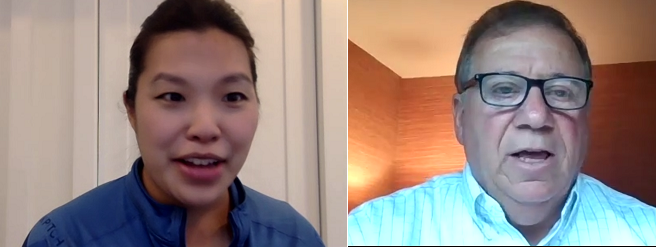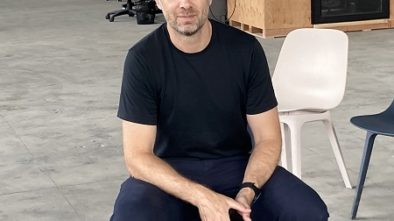Huge Opportunities in Healthtech and Supply Chain Emerge from Pandemic, NVP’s Lin Says
At the end of March, James Barrood hosted Joanne Lin, a principal at Newark Venture Partners, and Rudy Valli, a member of the Board of Trustees of JumpStart New Jersey Angel Network (New Brunswick), for an investor’s chat.
The first part of the discussion looked back on the various stages of the pandemic, and what it meant to the investors and the startups looking for funding. Later, the two discussed the future outlook, which both believe is rosy.
The situation didn’t seem rosy at first, however. Lin noted that, in April and May 2020, there was a lot of hesitation and concern from VCs about shifts in an entire industry “that used to be very reliant on in-person meetings, especially at the seed stage, where you really want to get to know the founders,” so you could invest in the founders and perform due diligence.
By the third and fourth quarter of last year, “there was a realization that this is going to be the norm for a while, and venture funds just had to continue to deploy capital, and we got used to doing diligence via Zoom. Deals continued to close.”
Early Concern for Existing Investments
Lin noted that a lot of “super” early-stage founders, pre-seed and angel-round founders really struggled. Most of the VC activity that did take place in the early days consisted of “insider-led rounds,” so startup founders without existing investors were at a disadvantage. “It’s really hard to drum up the right network, especially when things are digital only, so I knew there was a struggle for folks that didn’t already have a strong network.”
“We’re always going to have challenges, whether it’s a recession, or a new form of technological competition or regulation changes. And the really good people, the good managers and good leaders, find a way to survive and thrive. And take market share.”Rudy Valli, JumpStart
Valli recalled that the JumpStart angels were particularly concerned about the startups they had invested in, not knowing if these companies could survive. “I think after about three months, we felt like that had stabilized. The good ones pivoted, tightened their belts,” and went in other directions to gain some cash flow, he said.
Many investors were doing OK during the pandemic, even finding their personal net worth rising. “We were also eager to invest in opportunities that made sense. You had the dichotomy of some startups having cash-flow kinds of issues, “but for those organizations who knew how to manage cash flow and had a good story to tell, we were eager to listen.”
Virtual Meetings Changed Everything
He added that the experience of Zoom and virtual meetings changed how JumpStart conducted business. “It’s really increased the activity for us.” When JumpStart’s meetings were held face to face, they occurred once a month, typically including around three new entrepreneurial ventures. And certain JumpStart members inevitably couldn’t be there. “Now that we’re meeting virtually, we have greater level of activity, greater membership participation. And, interestingly enough, we’re also collaborating with other angels, so we have a greater pool of resources to offer the environment.”
Looking forward, Lin said that she isn’t seeing activity slowing down, especially as the country is coming out of the pandemic and seeing the light at the end of the tunnel. “I don’t see any reason why investment activity is going to slow down. The pipeline [of deals] is definitely not slowing down, and we think it’s definitely ramped up.”
She agreed with Valli that there’s an advantage to being remote only, as you can hold back-to-back pitch meetings. And plenty of founders are coming to the market.
Diversity Takes a Hit
Lin added this caveat: “I think, for entrepreneurs out there, that also means there’s a lot of noise in the market right now. There’s a lot of competition for the dollars that are out there and, unfortunately, I think one trend that we have seen is that investors, to some extent, have been flocking to what they know and what they’re comfortable with.”
She noted, for example, that in the second half of 2020 venture dollars for female founders actually decreased for the first time in three years. “Especially as we’re talking so much about diversity in the VC ecosystem, that’s disappointing to see. I’m hoping [that] as investors start to feel more comfortable with where we are, and that we’re moving out of a pandemic state, investments in women- and minority-led companies will pick up.”
Will Pandemic Pivots Last?
For those startups and their founders who made “pandemic pivots” to combat COVID, Valli doesn’t expect those pivots to last, and said that founders shouldn’t try pitching these pivots to angels. Instead, they need to be patient, and work on strategies for when their original products will be viable again.
He gave as an example his investment in a business that allowed people to monetize the parties they were giving. The founders were just about to launch a new marketing campaign when COVID-19 hit. They shut down the campaign, shut down their applications and focused their activity on creating the best product they could and on creating a strategy for when the situation changed back to normal. Valli believes that companies that made their money last through the pandemic, hunkered down and improved their products and strategies will thrive after the pandemic ends.
Brand New Entities with New Ideas
Looking forward, Valli said that JumpStart is beginning to talk to “brand-new entities who have new ideas. And I think, from our perspective, we’re open to any opportunity that makes sense. I emphasize [that this has] changed in the last six months. So, for those organizations who haven’t branched away, welcome, this inside is open now.”
One thing Valli mentioned that can give entrepreneurs an edge is being adept at communicating in a Zoom environment. “Personally, I’d rather interact with the founders in their physical environments, in terms of follow-up, and go to their places of business and touch everything. But that’s not being a part of the moment,” he said So, Valli has found other ways. He said it’s a measure of the entrepreneur’s creativity, in terms of how well they can demonstrate their business ideas, or opportunities, or their staffing or how well they’ve pivoted via Zoom.
For the future, Lin is enthusiastic about the healthcare and supply-chain market segments. “I think these are two that were dramatically changed because of COVID. I think that creates huge opportunities within those sectors for technology companies to try new things, and now investors are again reading the tea leaves and understanding where the puck is going. Eventually they’ll be more comfortable making those investments into brand-new ideas, which is how innovation happens.”
Added Valli, “We’re always going to have challenges, whether it’s a recession, or a new form of technological competition or regulation changes. And the really good people, the good managers and good leaders, find a way to survive and thrive. And take market share.”




